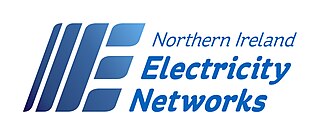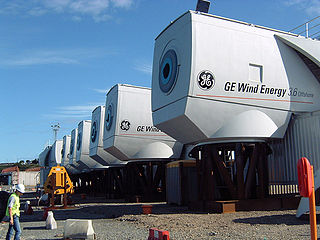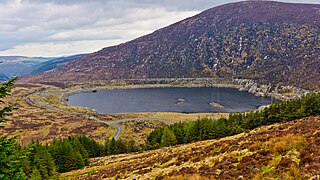
Electricity generation is the process of generating electric power from sources of primary energy. For utilities in the electric power industry, it is the stage prior to its delivery to end users or its storage.

Wind power is the use of wind energy to generate useful work. Historically, wind power was used by sails, windmills and windpumps, but today it is mostly used to generate electricity. This article deals only with wind power for electricity generation. Today, wind power is generated almost completely with wind turbines, generally grouped into wind farms and connected to the electrical grid.

The Electricity Supply Board is a state owned electricity company operating in the Republic of Ireland. While historically a monopoly, the ESB now operates as a commercial semi-state concern in a "liberalised" and competitive market. It is a statutory corporation whose members are appointed by the government of Ireland.

Northern Ireland Electricity Networks Limited (NIE Networks) is the electricity asset owner of the transmission and distribution infrastructure in Northern Ireland, established in 1993 when the business was privatised. NIE Networks does not generate or supply electricity. Since 2010 it has been a subsidiary of ESB Group.
The East–West Interconnector is a 500 MW high-voltage direct current submarine and subsoil power cable which connects the Irish and British electricity markets. The project was developed by the Irish national grid operator EirGrid.

Poolbeg Generating Station, colloquially known as The Poolbeg Stacks, is a power station owned and operated by the Electricity Supply Board of Ireland (ESB). There are two stations on the site, the older thermal station containing units 1, 2, and 3 and the combined cycle gas station containing units CG14, CG15 and ST16, which is located toward the eastern end of the site. The six units have a total installed capacity of 1020 MW.

Arklow Bank Wind Park is a 25 megawatt offshore wind farm generating electrical power for the Wicklow region in Ireland. It is the first offshore wind farm in Ireland, and the world's first erection of wind turbines rated over 3 MW. It is located on the Arklow Bank, a shallow water sandbank in the Irish Sea, around 10 kilometers (6.2 mi) off the coast of Arklow with an area of 27 by 2.5 kilometres.
Wind power in Ohio has a long history, and as of 2016, Ohio has 545 megawatts (MW) of utility-scale wind power installations installed, responsible for 1.1% of in-state electricity generated. Over 1000 MW more were under construction or pending approval. Some installations have become tourist attractions. There has been a sudden increase in generating capacity, as the total wind power capacity in the state was just 9.7 MW in 2010. By 2019, there were 738 MW of capacity, which generated 1.71% of Ohio's electricity.
As of 2021 the island of Ireland has 5,585 megawatt and the Republic of Ireland has 4,309 MW of installed wind power nameplate capacity, the third highest per capita in the world. In 2020 wind turbines generated 36.3% of Ireland's electrical demand, one of the highest wind power penetrations in the world.

Coolkeeragh power station is a power station near Derry in Northern Ireland.

Moneypoint power station is Ireland's largest electricity generation station and its only coal-fired power station. Commissioned between 1985 and 1987, it is located on the River Shannon, near Kilrush in County Clare, and was constructed at a cost of more than £700m. The station operates largely on coal, making it both unique in the context of Irish electricity production and the country's single largest emitter of greenhouse gases. It is capable of meeting around 25% of customer demand across the country. It has two Heavy Fuel Oil (HFO) storage tanks with a capacity of 50,000 tonnes which can be used as a back-up fuel if required.
Carrington Power Station is a combined cycle gas turbine power station, which was completed in Autumn 2016 and began commercial operation on 18 September 2016. It is located on the site of a former coal-fired power station, close to the villages of Carrington and Partington in the Greater Manchester Area and 12 km (7.5 mi) southwest of Manchester City Centre. The Manchester Ship Canal and the River Mersey run alongside the site, in Trafford, Greater Manchester, in North West England.
The electricity sectors of the Republic of Ireland and Northern Ireland are integrated and supply 2.5 million customers from a combination of coal, peat, natural gas, wind and hydropower. In 2022, 34 TWh were generated. In 2018 natural gas produced 51.8%, while wind turbines generated 28.1%, coal 7%, and peat 6.8% of Ireland's average electricity demand. In 2020 wind turbines generated 36.3% of Ireland's electrical demand, one of the highest wind power proportions in the world. While the United Kingdom was one of the first countries in the world to deploy commercial nuclear power plants, the island of Ireland has never had a nuclear power plant built on either side of the Irish border. Nuclear power in Ireland was discussed in the 1960s and 1970s but ultimately never phased in, with legislation now in place explicitly forbidding its introduction.
In 2016, Arizona had 268 megawatts (MW) of wind powered electricity generating capacity, producing 0.5% of in-state generated electricity.
Electric Ireland is an Irish utility company that supplies electricity and gas to business and residential customers in Ireland. It is the supply division of the Electricity Supply Board, the former monopoly electricity company in Ireland. The company now operates in an open market competing for the supply of retail electricity to residential customers. Electric Ireland sells a variety of smart technology, including Electric Vehicle Home Chargers, solar PV panels, battery storage, which are also sold by Electric Ireland's online shop. Other major suppliers include Airtricity and, more recently, Bord Gáis Energy.

Ireland is a net energy importer. Ireland's import dependency decreased to 85% in 2014. The cost of all energy imports to Ireland was approximately €5.7 billion, down from €6.5 billion (revised) in 2013 due mainly to falling oil and, to a lesser extent, gas import prices. Consumption of all fuels fell in 2014 with the exception of peat, renewables and non-renewable wastes.

The Turlough Hill Power Station is a pumped storage power station in Ireland, owned and operated by the Electricity Supply Board (ESB).

The Commission for Regulation of Utilities, formerly known as the Commission for Energy Regulation, is the Republic of Ireland's energy and water economic utility regulator.
Whitegate power station is a 445 MW combined cycle gas turbine (CCGT) electricity generating station near Whitegate, County Cork in Ireland. It was commissioned in 2010 and can supply up to ten percent of the electricity demand in Ireland.












